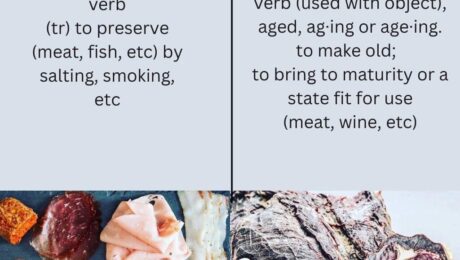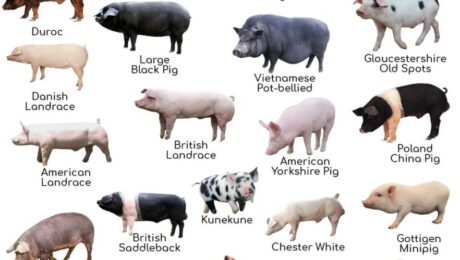Boar Taint
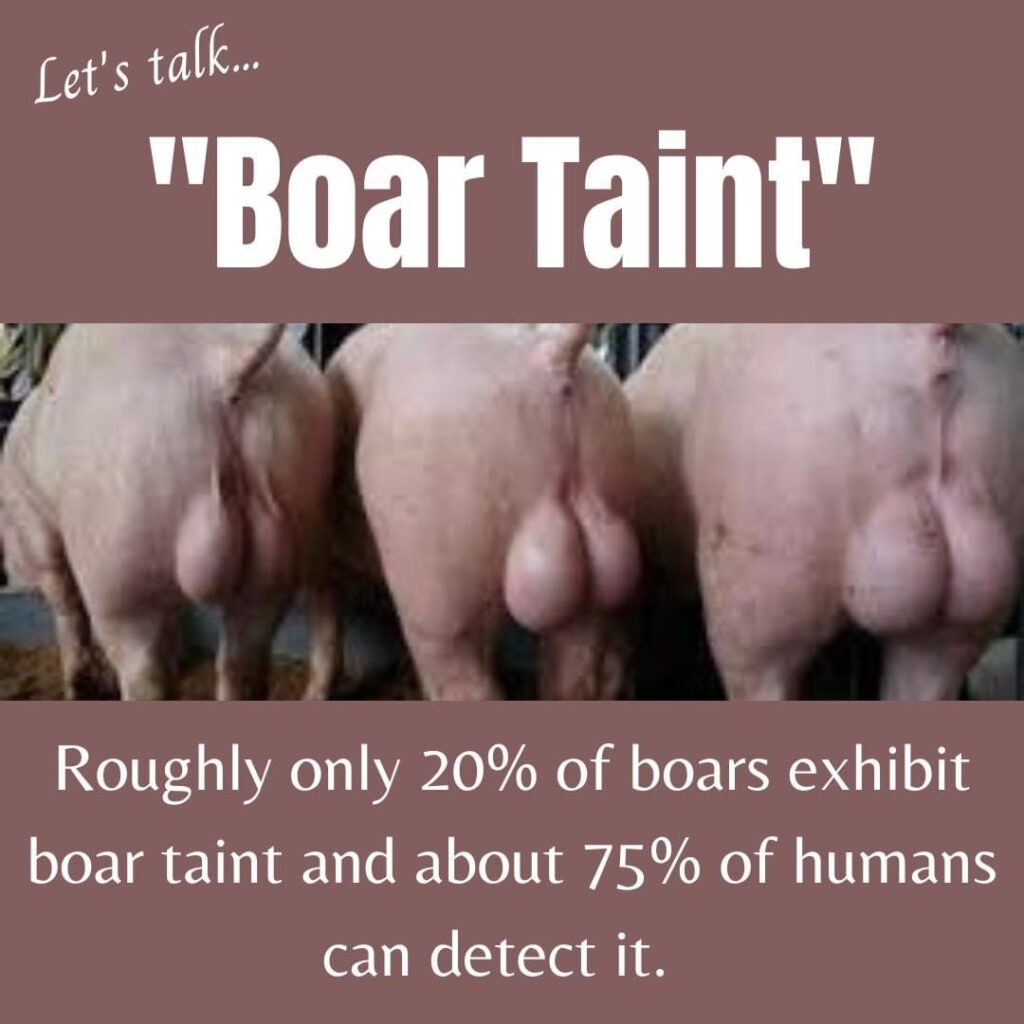
“Boar Taint” is a urine and/or fecal like smell/flavor that can be present in the fat of in-tact male pigs, aka boars, when cooked.

There are 2 main ingredients to “boar taint”: Androstenone and Skatole. Androstenone is a sex pheromone that begins to accumulate in the fat of boars once they reach maturity. Skatole is a digestive by-product formed in the intestines, also accumulating in fat. There are many factors that contribute to the levels of androstenone and skatole, such as age, genetics, season, feed and feed availability, environmental cleanliness, and the presence of sexually receptive females. I’ll touch a little on each of these. *This is simply information, not intended to scare you.

Roughly only 20% of boars exhibit boar taint and about 75% of humans can detect it. The risk is low, but for those who can taste it, if you happen to get one of the 20% with boar taint, it is completely repulsive, and most likely, inedible. Research suggests women are more susceptible to boar taint, but my personal experience is the opposite. The people I have met most sensitive to boar taint have all ironically been men, with women of the same household unaffected. You can also develop a sensitivity to boar taint with age. The more exposure you have to boar taint, the more likely you are to notice it.


Most boars reach maturity between 6-8 months of age, with slower growing breeds, such as kunekune, closer to the 12 month mark. The risk of boar taint cannot be completely eliminated by slaughtering boar pigs before they reach puberty, but it definitely lowers it.

Boar taint has been recorded higher in darker colored pigs, with Durocs at the top of the list. Boar taint could be controlled with genetic selection, but this would also directly effect feed conversion rates, reproductive and growth performance, and not just in males, which is why boar taint has not been effectively bred out (if that were even achievable). There has been some indefinite research suggesting lower risk of boar taint in lighter colored breeds such as Landrace, Yorkshire, Chester, and Gloucestershire Old Spots. However, there isn’t a lot of foundation to those claims, so I take it with a grain of salt.

With androstenone being a sex pheromone, it is no surprise there is a seasonal pattern. Androstenone levels are FIVE times higher from October through December. So if you are raising out boars for meat, keep this in mind when choosing your butcher date. I can confirm my own boar has started getting busy just in the last week. I’m dying for some baby pigs, so I’ve been cheering him along like his biggest fan.



Since skatole accumulates in the gut, there are some things we can do to lower those levels with diet. High fiber diets have been shown to reduce skatole absorption rates. Continuous feeding 15% fiber-rich chicory for 3–4 days before slaughter was sufficient to reduce skatole by 50–60%. When this was done for 2 weeks, it was completely eliminated.

*Availability and cost of chicory could be pricey, growing it could be an alternative solution.

The abundance of food is also a factor. Boars free fed will be less likely to exhibit boar taint at the butcher shop. On the flip side, excessive protein can lead to HIGHER skatole levels. This can be avoided by practising phase feeding, which varies the level of protein throughout the animal’s growth.



Skatole can be absorbed through skin contact or re-ingestion of feces. This is very simply avoided by providing a clean area for your boars. Pigs are ironically very hygienic on their own and typically defecate in one spot, so this *should be* an easy task. If your pigs are on pasture, rotating pastures might be necessary.

The presence of sexually receptive females stimulates a rapid rise in androstenone concentrations in boars. Growing boars with female pigs can also increase the intensity of odor in boar fat. Keep in mind, males can sense females in heat, so keeping them separate is only effective if they are housed fairly far away from each other or hard barriers are in place. Nobody likes mending fences and chasing pigs. I would also be weary of keeping more than a few adult boars together, as they could begin fighting for food. If you are raising boars for butcher with gilts, you might consider separation or processing before the gilts first heat cycle to reduce your risk of boar taint.

So why raise boars at all? If you are breeding, you simply can’t avoid it unless you are utilizing aritificial insemination. Literature is consistent: boars are up to 32% more feed efficient than castrated male pigs, aka barrows, and will dress out much leaner than barrows on the same diet. Barrows can thrive on lower quality diets, not that I am encouraging it, but it could help offset their lower feed efficiency rates.

Some people will argue ethics of castration. I am not some people. Castration is the answer to avoid boar taint all together. It is ideal to castrate between 1-3 weeks of age. The smaller they are, the easier this will be on you, if you are performing the castration yourself. Vets can castrate pigs at any age under anesthesia, so if you have an older boar that’s being retired to the freezer, this is something you can do a few months prior to processing if taint is a concern. Since pig testicles do not hang down like ruminants, banding is not an option. And since it came up recently, pig vasectomies do not exist. Testicles must be removed entirely to produce a barrow.



It is important to also note that boar taint is only evident when pork is heated. So if you already have a smelly pig on the chopping block, he would be an excellent candidate for charcuterie, since no heat is required.

The addition of spices can help in masking boar taint. Cutting a boar into sausage is a good choice as well. We recently just added chorizo to the menu, giving you FIVE different flavors of sausage so you don’t get bored with just one.





*I can not 100% guarantee you won’t still notice some boar taint even in sausage, as that will be heavily dependent on your sensitivity to it and the intensity of the taint.
- Published in Ag Practices
Cured Meats VS Aged Meats:What’s the difference?

Cured meats are preserved by the addition of salt, with the aim of drawing moisture out of the food by the process of osmosis. Because curing increases the solute concentration in the food and hence decreases its water potential, the food becomes inhospitable for the microbe growth that causes food spoilage. Curing can be traced back to antiquity, and was the primary method of preserving meat and fish until the late 19th century. Dehydration was the earliest form of food curing. Many curing processes also involve smoking, spicing, cooking, or the addition of combinations of sugar, nitrate, and nitrite. The most common cured meats includes bacon, ham, salami, corned beef, kielbasa, blood sausage, andouille, pepperoni, pastrami, bologna, and prosciutto.
Aging is a process of preparing meat for consumption by letting the meat rest in temperatures just above freezing in order to break down the connective tissue within the meat. The two methods of aging meat are wet and dry aging. It is also the same process that occurs in meat that is “hung” in refrigeration.
To simplify, curing is a form of preserving meat and aging is like reverse rigor mortis, a form of tenderizing.
I see a lot of folks using these terms interchangeably. I hope this helps!
- Published in Ag Practices
Scheduling with The Farmer’s Almanac
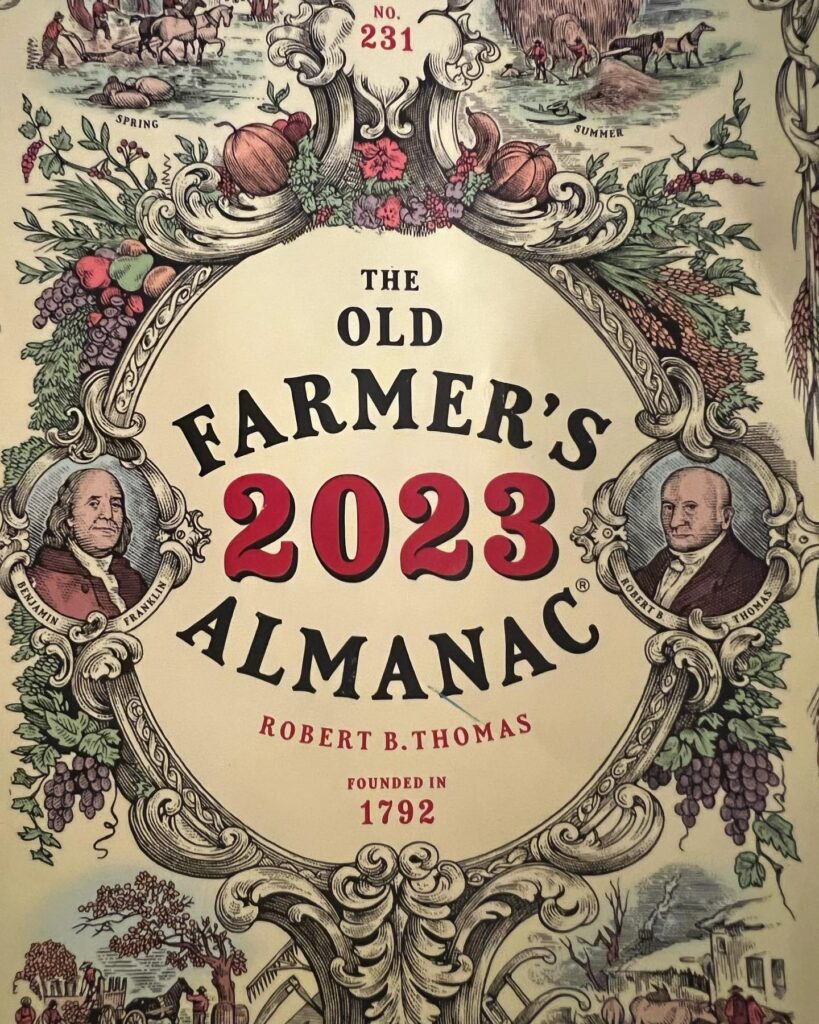
Staying warm and reading the 2023 Farmer’s Almanac today, found some interesting info!
According to the Almanac, here are the “Best Days” to slaughter livestock in 2023:
Jan. 15-17
Feb. 12, 13
March 11, 12
April 7, 8
May 4-6
June 1, 2, 28, 29
July 25-27
August 22, 23
September 18, 19
October 15-17
November 12, 13
December 9, 10
These dates are based on the Moon’s sign.
- Published in Ag Practices
Pig Breeds, choosing the “right” one for you
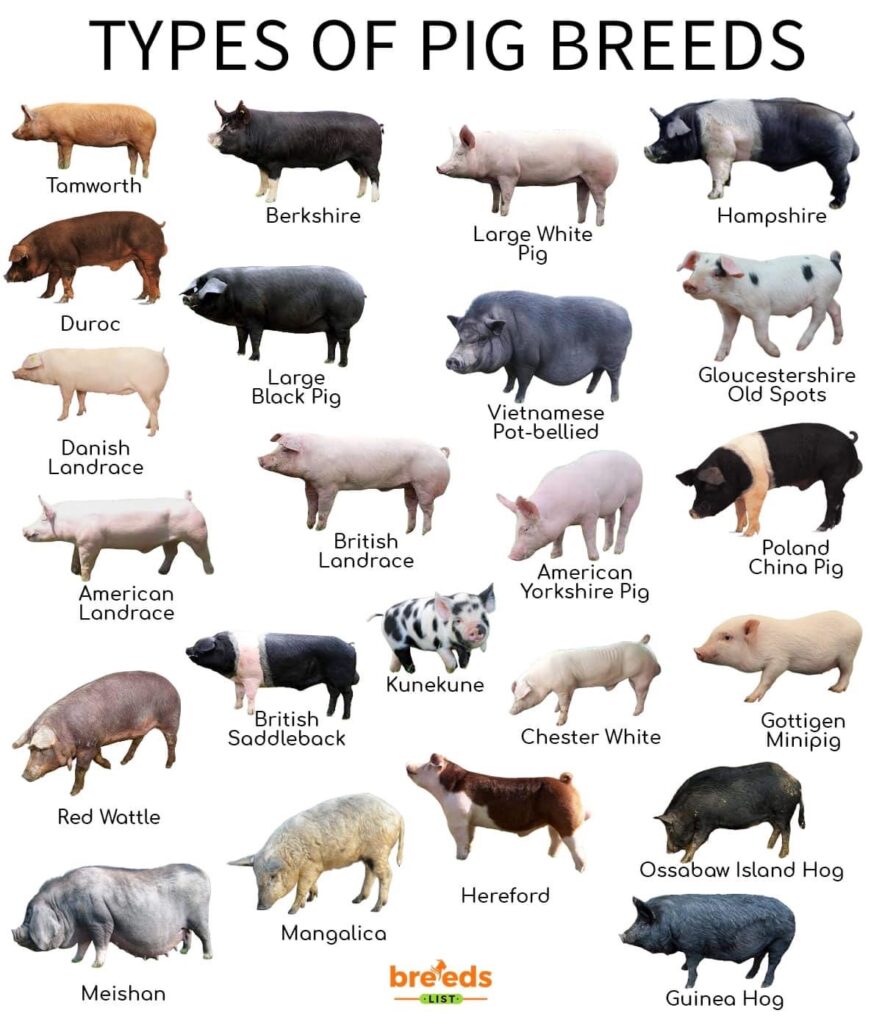
I’m often asked about what breeds I think are best (for meat). My response is always the same- they are all edible. What your goals and priorities are, however, will help you decide on a breed.
I’m going to talk about pigs, because it is perfect pig buying weather! Pigs are a bit easier to raise in colder months, imo.
If what you need is something with the quickest turnaround- look no further than some of the more popular breeds such as Duroc, Berkshire, Hampshire, Chester, Landrace, Yorkshire, Poland China, and/or any cross in between. Hereford pigs are also growing in popularity. These breeds will reach maturity within 6-8mo. I would not rely on these breeds to live on pasture. I have personally used these breeds when I had lots of free scraps from restaurants, which they love. However, if you do not have this available, you’ll be looking at buying bagged feed.
If you have a bit more time, you might look into some heritage breeds such as Kunekune, American Guinea Hog, Idaho Pasture Pig, Gloucestershire Old Spot, Meishan, Mangalitsa, Red Wattle, Tamworth, and Large Black. Most of the breeds mentioned here are considered to be a ‘Lard Pig’. This means they will produce a large amount of fat, if allowed to eat a diet heavy in fatty food. But just as someone can raise a fat Yorkshire, a lean Kunekune is attainable as well, if given a breed-appropriate diet. Most of these breeds will take close to a year (or longer) to reach maturity, with Kunekune and AGH among the smallest and GOS and Large Black among the largest. These breeds are best suited on pasture, supplemented with hay in the winter.
I highly recommend doing some research on your breed and working with a reputable breeder for stock. Each breed has different needs and will have different characteristics that will help you choose what is best suited to your situation. Define what your goals are with pigs and picking a breed will become a lot clearer.
Things to consider:
-Fencing availability
-Feed availability
-Mothering instincts
-Temperament
-Purchase Price
-Size
-Foraging Ability
-Growth Rate
-Meat Preference
- Published in Ag Practices
So you got an animal to fatten up for the freezer, but when do you butcher it?

Most butchers book out months (or years) in advance! So if you don’t want to pay for any unnecessary extra feeding, you’ll need to plan this part out long before your animal is “ready” for butcher.
Generally speaking, butchering just around maturity is ideal for most animals. You utilize the full size of the animal, at it’s younger point in life for more tender meat (and less investment).
Your first place of reference is your breeder. Whomever you purchased that animal from likely has experience with that breed, specifically that blood line, can tell you approximately when they’ll reach maturity.
If you did not buy your animal from a breeder, you’ll be basing it off of breed standards and how you intend to feed it. Keep in mind, animal growth time will be higher in grain fed animals and slower in grass fed animals.
Don’t know your breed? Ask. There are so many resources here on social media and local to you that will help you determine what you have and approximately when it should reach maturity.
However, you may find yourself with an animal that isn’t in that “ideal” age range to butcher that you still need to send to freezer camp. I’m here with a little secret: they are all edible.
The reality is, when to butcher is entirely based on your needs and preference. You can butcher a suckling pig just as you can butcher a 5yr old sow at 600lbs. Are these going to yield two completely different products? Of course they are. Are they both valuable protein? Of course they are.
Whether it’s your sons first show critter perfectly timed for a butcher date, an old breeder that no longer serves you, or just an asshole escape artist that needs to go, we’re here to help time your butcher date perfectly for you!
- Published in Ag Practices




